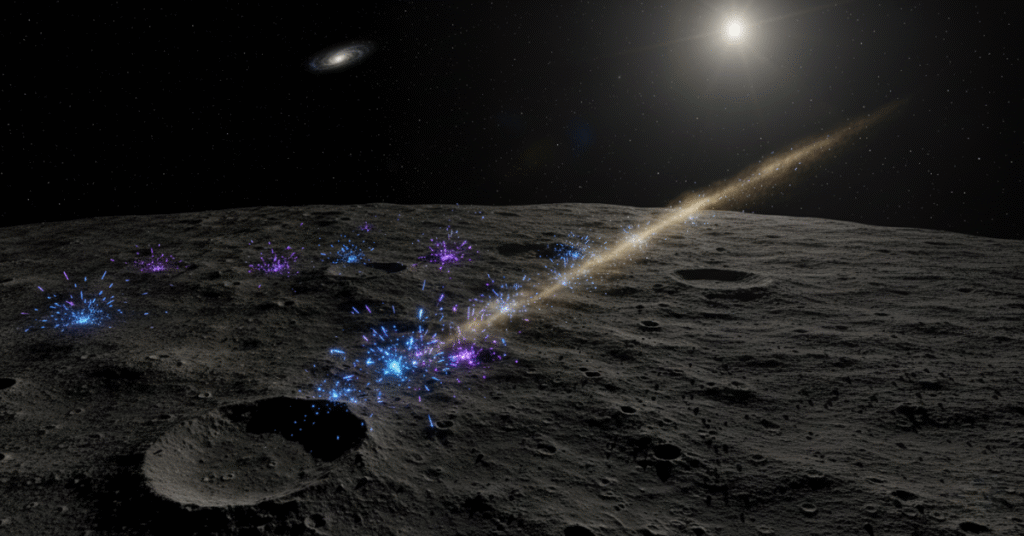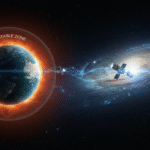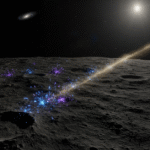What are nano-flares on the lunar surface? This fascinating question leads us to one of the most significant and recent discoveries in space science, completely changing how we view our Moon. For years, the scientific community thought of the Moon as a silent, static rock. However, the latest data reveals a different, far more dynamic truth: its surface is constantly flickering with minuscule energy bursts. This is a thrilling revelation for anyone who tracks space facts, and as a writer, I find the concept of microscopic energy on a planetary body deeply compelling—it forces us to rethink what ‘dead’ truly means in space.
This discovery is not just an amazing scientific fact; it is a critical piece of the puzzle that holds the key to the future of deep space exploration and our ambitious goal of building sustainable habitats beyond Earth.
5 Facts Defining Nano-Flares
To begin, we must clearly define the phenomenon. Understanding what are nano-flares on the lunar surface requires a look at their mechanism and scale.
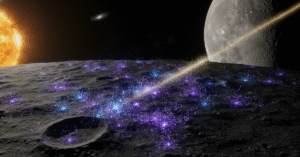
Fact 1: They are the Smallest Energy Bursts Detected
Nano-flares are ultra-small, ultra-fast flashes of light and heat. They are named for their minute scale, representing the smallest, most rapid energy releases observed on a solid celestial body in our solar system. Their detection is a monumental achievement in instrumentation.
Fact 2: They are Fueled by the Solar Wind
The flares are a direct result of the Moon’s constant bombardment by the solar wind, which is a powerful, high-speed stream of charged particles flowing out from the Sun. This relentless solar energy is the direct driver of the phenomenon.
Fact 3: The Moon’s Vacuum is the Key Condition
The Moon’s environment is unique because it lacks a thick atmosphere and a protective global magnetic field. This means there is nothing to shield the surface, allowing the solar wind to hit the lunar material directly.
Fact 4: They are Created by Regolith Impacts
The flares occur when the high-speed charged particles from the solar wind slam into the Moon’s fine, dusty topsoil, known as regolith. The force of this collision instantly converts into a minute burst of light and heat.
Fact 5: They Confirm the Moon is Electrically Active
The continuous occurrence of these bursts establishes the Moon as a dynamically active electrical environment. This finding completely changes the older, static view. This persistent activity answers precisely what are nano-flares on the lunar surface.
5 Facts Explaining Their Strategic Importance
The discovery’s true value lies in its impact on our future missions. These facts explain why studying what are nano-flares on the lunar surface is strategically crucial.
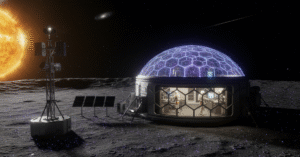
Fact 6: They Cause the Problem of ‘Sticky Lunar Dust’
This is perhaps the most critical practical fact for astronauts. The energy from these nano-flares constantly alters the electrical charge of the regolith. This electrostatic charging makes the lunar dust incredibly abrasive and sticky, posing a major threat to equipment and habitats. (You can read more about the risks of lunar dust on NASA’s website.)

Fact 7: Nano-Flares Help Map Radiation Levels
By monitoring these tiny flares, scientists gain a more precise picture of the overall radiation and particle environment astronauts will face. This data is essential for ensuring that future lunar bases are built with the correct shielding materials in the safest locations.
Fact 8: They Provide a Model for Other Airless Bodies
The Moon acts as an accessible laboratory. The specific data gathered here can be extrapolated to study distant, airless objects like Mercury (which faces even more intense solar radiation) and various asteroids. This expands our knowledge of space weathering.
Fact 9: They Affect Lunar Resource Chemistry
Future lunar bases will depend on using local resources (In-Situ Resource Utilisation or ISRU). The constant energy transfer from the nano-flares can alter the chemical bonds within the regolith, impacting efforts to extract vital resources like oxygen and water ice.
Fact 10: They Are Fundamentally Different from Solar Flares
It is vital to distinguish these from a massive, mission-threatening Solar Flare. Nano-flares are localized surface events (microscopic), whereas solar flares are global magnetic disruptions (millions of kilometers). Knowing what are nano-flares on the lunar surface helps ground control avoid false alarms and assess real threats accurately.
Conclusion: A New Era of Lunar Science
The confirmation of the nano-flares on the lunar surface marks a new era in our scientific understanding. It transforms the Moon from a historical site into a dynamic scientific frontier.
The fact that we are now studying phenomena at the nano-scale hundreds of thousands of miles away is, in my experience, a true testament to human ingenuity. This detailed, up-to-date knowledge about the lunar environment, particularly what are nano-flares on the lunar surface, is not just for our science textbooks—it is the engineering blueprint for our future in space.

